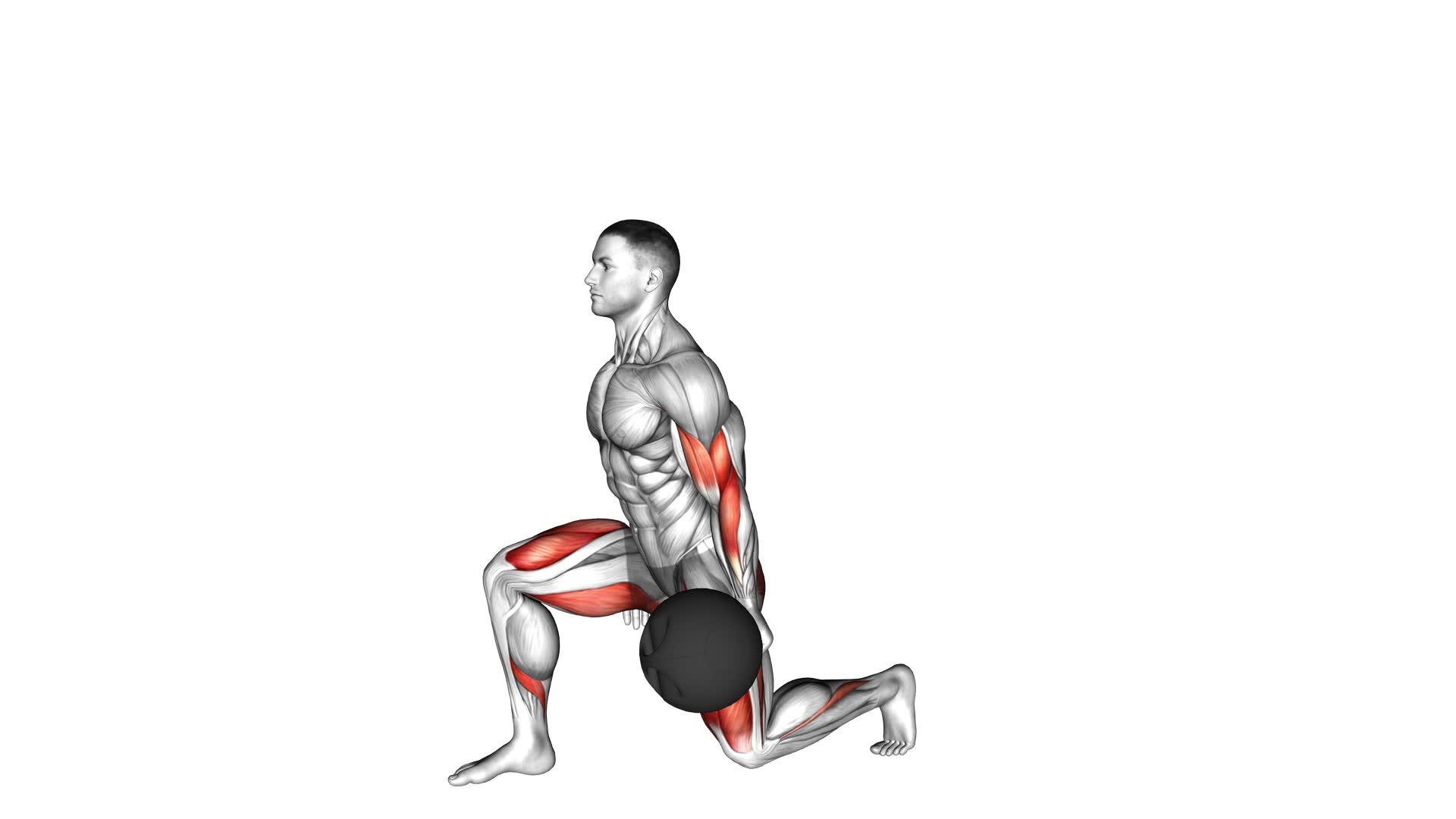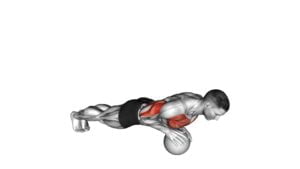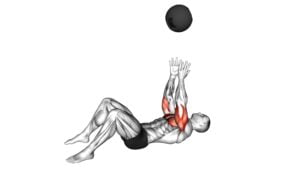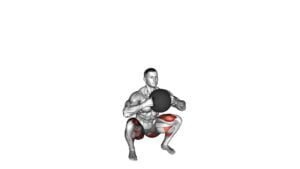Medicine Ball Lunge With Biceps Curl – Video Exercise Guide & Tips

Are you looking for a challenging exercise that targets multiple muscle groups? Look no further than the Medicine Ball Lunge With Biceps Curl.
Watch This Exercise Video
This exercise combines a lunge with a biceps curl, giving you a full-body workout in one move. By incorporating a medicine ball, you add an extra level of resistance and stability training.
In this article, we'll show you the proper form and technique, variations for different fitness levels, and tips for maximizing your results.
Let's get started!
Key Takeaways
- Targets multiple muscle groups simultaneously
- Improves balance and coordination
- Increases muscle strength in both lower body and upper body
- Provides a full-body workout in one move
Benefits of the Medicine Ball Lunge With Biceps Curl
When performing the Medicine Ball Lunge With Biceps Curl, you can experience a range of benefits from this exercise.
This compound exercise targets multiple muscle groups simultaneously, making it an efficient choice for your workout routine. One of the key benefits of this exercise is that it helps in improving balance. By incorporating the medicine ball into the lunge movement, you challenge your stability and engage the muscles responsible for maintaining balance. This can be particularly beneficial for athletes or individuals who want to enhance their coordination and stability.
Another benefit of the Medicine Ball Lunge With Biceps Curl is that it increases muscle strength. The lunge movement primarily targets the lower body muscles such as the quadriceps, hamstrings, and glutes. By adding the biceps curl, you also engage the muscles in your arms, specifically the biceps. This exercise helps in developing both lower body and upper body strength, making it a great choice for overall muscle development.
To perform the Medicine Ball Lunge With Biceps Curl, you'll need a few pieces of equipment. Firstly, you'll need a medicine ball that's suitable for your fitness level and preference. Additionally, it's recommended to have a pair of dumbbells for the biceps curl component of the exercise. These equipment items will allow you to effectively perform the exercise and maximize its benefits.
Equipment Needed for the Exercise
To perform the Medicine Ball Lunge With Biceps Curl, you'll need a medicine ball and a pair of dumbbells. Here's a breakdown of the equipment needed and modifications for different fitness levels:
- Medicine Ball:
Choose a medicine ball that's appropriate for your strength and fitness level. Beginners may start with a lighter ball, around 4-6 pounds, while more advanced individuals can opt for a heavier ball, up to 10-12 pounds. The medicine ball should be comfortable to hold and grip securely during the exercise.
- Dumbbells:
A pair of dumbbells is essential for the biceps curl portion of the exercise. The weight of the dumbbells will depend on your strength and fitness level. Beginners can start with lighter dumbbells, around 5-8 pounds, while those with more experience can use heavier dumbbells, up to 15-20 pounds. Make sure the dumbbells are comfortable to hold and allow for proper form throughout the exercise.
- Modifications for Different Fitness Levels:
If you're just starting out or have limited mobility, you can perform the exercise without weights or with lighter weights. As you progress, you can gradually increase the weight of the medicine ball and dumbbells. Additionally, you can modify the range of motion by adjusting the depth of the lunge or the height of the biceps curl. Always listen to your body and choose the modifications that challenge you while maintaining proper form.
Proper Form and Technique
To ensure proper form and technique for the Medicine Ball Lunge With Biceps Curl exercise, focus on maintaining a stable lunge position and engaging your biceps throughout the movement. This exercise is a great addition to your workout routine as it targets multiple muscle groups, including your quadriceps, glutes, hamstrings, and biceps.
One common mistake to avoid is allowing your front knee to extend past your toes during the lunge. This can put unnecessary strain on your knee joint and decrease the effectiveness of the exercise. Instead, focus on keeping your weight centered on your front heel and maintaining a 90-degree angle between your front thigh and calf.
Another common mistake is using momentum to swing the medicine ball during the biceps curl. This takes away the resistance and reduces the benefits of the exercise. Instead, focus on a slow and controlled movement, squeezing your biceps at the top of the curl to fully engage the muscle.
Remember to maintain proper posture throughout the exercise by keeping your chest lifted, shoulders back, and core engaged. By following these tips, you can maximize the benefits of the Medicine Ball Lunge With Biceps Curl and improve your overall strength and muscle tone.
Variations and Modifications for Different Fitness Levels
To accommodate beginners, you can start by performing the lunge without the medicine ball and gradually add it in as you build strength and stability.
For a more advanced variation, you can increase the weight of the medicine ball or even try using a kettlebell instead.
It's important to adapt the exercise to your fitness level to ensure proper form and prevent injury.
Beginner Modifications for Lunge
Achieving optimal fitness levels can be facilitated by incorporating various modifications and variations into your lunge routine. As a beginner, it's important to start with modifications that prioritize proper technique and gradually increase intensity. Here are three beginner modifications to consider:
- Stationary Lunges: Instead of stepping forward or backward, perform lunges in place. This reduces the complexity and helps you focus on mastering the correct form before progressing to more dynamic variations.
- Elevated Lunges: Place your front foot on a step or platform. This modification decreases the range of motion and reduces the strain on your knees, making it ideal for beginners or those with knee issues.
- Reverse Lunges: Instead of stepping forward, step backward. This modification shifts the focus to your hamstrings and glutes, allowing for greater stability and control.
Advanced Variations for Curl
As you progress in your lunge routine, you can further challenge your biceps muscles by incorporating advanced variations for the curl exercise.
Advanced modifications and techniques can help you take your biceps curls to the next level and continue to build strength and endurance.
One advanced modification is the incline curl, where you perform the curl exercise on an incline bench. This increases the difficulty by placing more emphasis on the biceps.
Another advanced technique is the concentration curl, where you isolate the biceps by performing curls with one arm at a time while sitting on a bench. This helps improve muscle definition and targeting specific areas of the biceps.
Adapting for Different Abilities
As you progress in your fitness journey, it's important to adapt your exercises to your current fitness level in order to continue challenging yourself and achieving your goals. Here are three ways to adapt exercises for different abilities:
- Adapting for injuries: If you have an injury, it's crucial to modify exercises to avoid further damage. For example, if you have a knee injury, you can replace lunges with seated leg exercises or use resistance bands for a lower impact workout.
- Modifying for older adults: Older adults may have limitations due to age-related factors such as decreased mobility or balance. It's important to choose exercises that are safe and effective. For instance, instead of traditional lunges, older adults can do modified lunges using a chair for support.
- Gradually increasing intensity: As you become stronger and more proficient, you can gradually increase the intensity of the exercise by adding more weight or increasing repetitions.
By adapting exercises to suit your abilities, you can minimize the risk of injuries and maximize your results.
Now, let's move on to tips for maximizing results and avoiding common mistakes.
Tips for Maximizing Results and Avoiding Common Mistakes
To maximize your results and avoid common mistakes, make sure to focus on maintaining proper form and technique throughout the Medicine Ball Lunge With Biceps Curl exercise. This won't only help you maximize the intensity of the exercise, but also prevent any potential injuries.
First and foremost, it's important to engage your core muscles throughout the entire exercise. This will help stabilize your body and maintain balance.
As you perform the lunge, make sure to keep your front knee aligned with your ankle and avoid letting it extend past your toes. This will help prevent any unnecessary strain on your knee joint.
When performing the biceps curl, keep your elbows close to your body and avoid swinging your arms. This will ensure that your biceps are properly engaged and that you're getting the most out of the exercise.
Additionally, it's important to choose an appropriate weight for the medicine ball. Start with a weight that challenges you, but allows you to maintain proper form. Gradually increase the weight as you become stronger and more comfortable with the exercise.
Sample Workout Routine Incorporating the Medicine Ball Lunge With Biceps Curl
To get the most out of your workout routine incorporating the Medicine Ball Lunge with Biceps Curl, it's important to focus on proper exercise form. Keep your back straight, engage your core, and maintain a controlled movement throughout the exercise.
For beginners, variations such as using a lighter medicine ball or performing the exercise without weights can help build strength and confidence.
Combining the lunge and biceps curl not only targets multiple muscle groups simultaneously but also improves overall coordination and functional fitness.
Exercise Form Tips
To perform the exercise with proper form, start by standing with your feet shoulder-width apart. Keep your back straight and engage your core throughout the movement.
Here are some exercise form tips to ensure you perform the Medicine Ball Lunge With Biceps Curl correctly:
- Step forward with one leg and lower your body into a lunge position, making sure your front knee is directly above your ankle.
- As you lunge, simultaneously curl the medicine ball towards your shoulders, keeping your elbows close to your body.
- Push through your front heel and return to the starting position, while straightening your arms and lowering the medicine ball.
By following these proper technique tips, you can maximize the benefits of the exercise and reduce the risk of injury.
Now let's move on to the next section to explore variations for beginners.
Variations for Beginners
If you're a beginner looking to incorporate the Medicine Ball Lunge With Biceps Curl into your workout routine, here are some variations to consider. These beginner modifications will help you build strength and improve your form while performing the exercise.
- Stationary Lunges: Start by standing with your feet hip-width apart and hold the medicine ball in front of your chest. Take a step forward with your right foot and lower your body into a lunge position. Keep your back straight and your knee directly above your ankle. Push through your right heel to return to the starting position and repeat with the left leg.
- Reverse Lunges: Begin by standing with your feet hip-width apart and hold the medicine ball in front of your chest. Take a step back with your right foot and lower your body into a lunge position. Keep your back straight and your knee directly above your ankle. Push through your left heel to return to the starting position and repeat with the right leg.
- Walking Lunges: Start by standing with your feet hip-width apart and hold the medicine ball in front of your chest. Take a step forward with your right foot and lower your body into a lunge position. Keep your back straight and your knee directly above your ankle. Push through your right heel to bring your left foot forward into the next lunge position. Continue walking forward, alternating legs.
Incorporating these lunge variations into your workout routine will provide a well-rounded lower body workout while adding an upper body element with the biceps curl. Remember to start with light weights and focus on maintaining proper form throughout the exercise.
Benefits of Combining Exercises
Combine exercises to maximize your workout and enhance the benefits of the Medicine Ball Lunge With Biceps Curl. By incorporating exercise combinations into your routine, you can target multiple muscle groups simultaneously, saving time and increasing efficiency.
Here are three key benefits of combining exercises:
- Increased calorie burn: Combining exercises that engage different muscle groups increases the intensity of your workout, leading to a higher calorie burn. The Medicine Ball Lunge With Biceps Curl, for example, activates the leg muscles, glutes, biceps, and core, resulting in a more effective calorie-burning session.
- Improved muscle activation: Performing compound exercises like the Medicine Ball Lunge With Biceps Curl engages multiple muscles at once, leading to greater muscle activation. This promotes strength gains and muscular development throughout your entire body.
- Enhanced functional fitness: Combining exercises mimics real-life movements and challenges your body in a functional way. This improves your overall fitness and helps you perform daily activities with greater ease and efficiency.
Incorporate exercise combinations into your routine to maximize your workout and reap the benefits of improved muscle activation and functional fitness.
Frequently Asked Questions
How Many Sets and Reps Should I Do for the Medicine Ball Lunge With Biceps Curl?
For the medicine ball lunge with biceps curl, it's important to know how many sets and reps to do. The recommended number of sets and reps for this exercise will depend on your fitness level and goals.
To start, you can try doing 3 sets of 10-12 reps on each leg. This will help you build strength and improve your balance.
As you progress, you can increase the number of sets and reps to challenge yourself even more.
Can I Use Dumbbells Instead of a Medicine Ball for This Exercise?
Yes, you can use dumbbells instead of a medicine ball for the Medicine Ball Lunge With Biceps Curl exercise. This exercise allows for alternative equipment such as dumbbells, providing a modification for those who prefer or have access to different equipment.
Using dumbbells can still effectively target the lower body and biceps, allowing you to achieve similar benefits as with a medicine ball. Remember to maintain proper form and adjust the weight accordingly for your fitness level.
Is There a Specific Weight Range I Should Use for the Medicine Ball?
When it comes to the specific weight range for the medicine ball, it's important to consider your fitness level and goals.
Start with a weight that challenges you but allows for proper form and control throughout the exercise. You can gradually increase the weight as you get stronger.
Remember, the goal is to maintain good technique and avoid any strain or injury.
If you have any concerns or limitations, consult with a fitness professional for exercise modifications.
Can I Do This Exercise if I Have Knee or Back Problems?
If you have knee or back problems, it's important to consider modifications for the medicine ball lunge with biceps curl exercise. This exercise can put strain on these areas, so it may not be suitable for everyone.
It's best to consult with a healthcare professional or a certified trainer who can provide alternative exercises that won't aggravate your condition. Safety is key when it comes to exercising with knee or back issues.
How Often Should I Incorporate the Medicine Ball Lunge With Biceps Curl Into My Workout Routine?
To maximize the benefits of incorporating the medicine ball lunge with biceps curl into your workout routine, it's essential to understand how often to perform this exercise.
By regularly including this exercise in your routine, you can enhance lower body strength, improve balance, and develop biceps muscles.
However, it's recommended to consult with a fitness professional to determine the appropriate frequency based on your fitness level and goals.
Additionally, you can explore variations of this exercise for added challenge and to target different muscle groups.
Conclusion
In conclusion, the medicine ball lunge with biceps curl is a highly effective exercise that targets multiple muscle groups, including the legs, glutes, biceps, and core.
By incorporating this exercise into your workout routine, you can improve strength, stability, and coordination.
Remember to use proper form and technique, and make modifications as needed for your fitness level.
By following these tips and incorporating this exercise into a well-rounded workout routine, you can maximize results and avoid common mistakes.

Author
Years ago, the spark of my life’s passion ignited in my mind the moment I stepped into the local gym for the first time. The inaugural bead of perspiration, the initial endeavor, the very first surge of endorphins, and a sense of pride that washed over me post-workout marked the beginning of my deep-seated interest in strength sports, fitness, and sports nutrition. This very curiosity blossomed rapidly into a profound fascination, propelling me to earn a Master’s degree in Physical Education from the Academy of Physical Education in Krakow, followed by a Sports Manager diploma from the Jagiellonian University. My journey of growth led me to gain more specialized qualifications, such as being a certified personal trainer with a focus on sports dietetics, a lifeguard, and an instructor for wellness and corrective gymnastics. Theoretical knowledge paired seamlessly with practical experience, reinforcing my belief that the transformation of individuals under my guidance was also a reflection of my personal growth. This belief holds true even today. Each day, I strive to push the boundaries and explore new realms. These realms gently elevate me to greater heights. The unique combination of passion for my field and the continuous quest for growth fuels my drive to break new ground.







